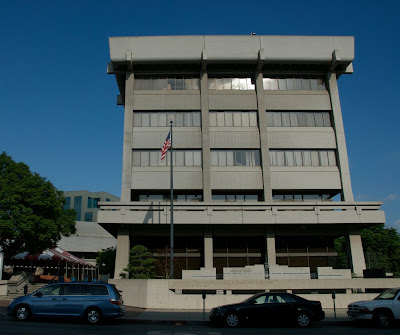 Located in revitalized Little Tokyo, the Japanese American Cultural and Community Center houses a rock garden sculpture, sunken garden and plaza, and highlights Japanese heritage and history.
Located in revitalized Little Tokyo, the Japanese American Cultural and Community Center houses a rock garden sculpture, sunken garden and plaza, and highlights Japanese heritage and history.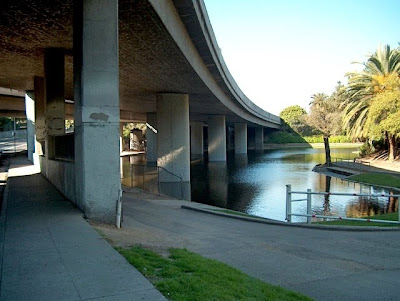 Hollenbeck Park is one of the few open green spaces in East Los Angeles. The park was once an idyllic place for recreation and community gathering. The construction of a freeway through the lake in the park destroyed its serenity. Hollenbeck Park remains popular for the disproportionately Latino residents of East L.A.
Hollenbeck Park is one of the few open green spaces in East Los Angeles. The park was once an idyllic place for recreation and community gathering. The construction of a freeway through the lake in the park destroyed its serenity. Hollenbeck Park remains popular for the disproportionately Latino residents of East L.A.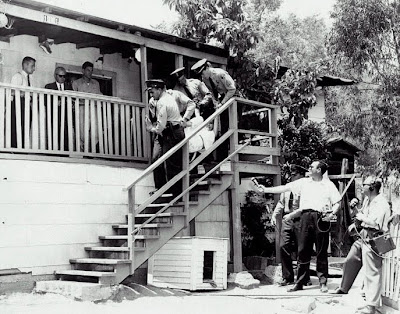 Chavez Ravine was a bucolic Latino community through the 1950s, until the City of Los Angeles forcibly evicted the residents with promises of affordable housing. Mrs. Aurora Archega, whose family had resided in Chavez Ravine for 36 years, refused to leave her home, and was carried out by the police, with all of her belongings, on May 9, 1959, in a scene captured in this classic photograph. She was then jailed for 30 days. The City authorized the sale of Chavez Ravine to the Dodgers for a stadium 50 years ago on October 7, 1957. The Dodgers drowned Chavez Ravine in a sea of asphalt to build Dodger Stadium and a parking lot for 50,000 cars and not a single place for children to play. The Dodgers promised to spend $500,000 on a recreation facility in the area but have never done so. Los Desterrados, the people who lost their homes and way of life at Chavez Ravine, still meet regularly to commemorate the community there. Judy Baca and SPARC's Great Wall of Los Angeles commemorate these events. Culture Clash revived the forgotten history of Chavez Ravine in their play of that name, and Ry Cooder in his CD. Read the L.A. Times coverage of the 50th anniversary.
Chavez Ravine was a bucolic Latino community through the 1950s, until the City of Los Angeles forcibly evicted the residents with promises of affordable housing. Mrs. Aurora Archega, whose family had resided in Chavez Ravine for 36 years, refused to leave her home, and was carried out by the police, with all of her belongings, on May 9, 1959, in a scene captured in this classic photograph. She was then jailed for 30 days. The City authorized the sale of Chavez Ravine to the Dodgers for a stadium 50 years ago on October 7, 1957. The Dodgers drowned Chavez Ravine in a sea of asphalt to build Dodger Stadium and a parking lot for 50,000 cars and not a single place for children to play. The Dodgers promised to spend $500,000 on a recreation facility in the area but have never done so. Los Desterrados, the people who lost their homes and way of life at Chavez Ravine, still meet regularly to commemorate the community there. Judy Baca and SPARC's Great Wall of Los Angeles commemorate these events. Culture Clash revived the forgotten history of Chavez Ravine in their play of that name, and Ry Cooder in his CD. Read the L.A. Times coverage of the 50th anniversary.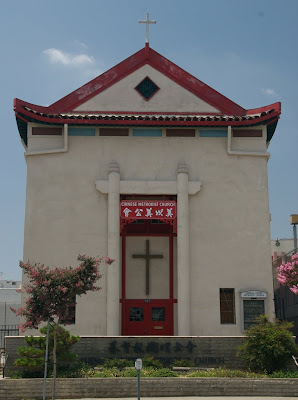 Founded in 1887 by a small group of Chinese Christians, the church was located on North Los Angeles Street, just a few buildings from where the Chinese American Museum now stands. It was the first church in Chinatown. In 1947, the church moved to 825 North Hill Street, where it is located today.
Founded in 1887 by a small group of Chinese Christians, the church was located on North Los Angeles Street, just a few buildings from where the Chinese American Museum now stands. It was the first church in Chinatown. In 1947, the church moved to 825 North Hill Street, where it is located today.Built between 1887 and 1888 for GW Morgan, the house was sold numerous times and moved twice before coming to the museum.
Originally located at 4501 North Pasadena Ave (now Figueroa St), it was purchased by James and Bessie Hale in 1906 at it’s 2nd location, 4425 N. Pasadena Ave. James was a motor man for the railroad. The couple separated a few years after moving in-Bessie remained in the house and took in boarders and bought and sold real estate in the hot property market of the early 20th century in Los Angeles. Moved to the museum in 1970, the house underwent a large restoration effort. It is a classic example of a Queen Anne/Eastlake style house. Queen Anne details include fish scale shingles, corner turret, iron grillwork and dentil blocks.
Charles Locke Eastlake was a renowned interior designer of the period. The Hale House’s extensive surface decorations, including chrysanthemums, fans, and geometric designs can be found in Eastlake’s book, Hints on Household Taste. Unfortunately for Eastlake, many of the designs that he abhorred were adopted by the homeowners and furniture makers alike who copied all of the designs in his book-the good and bad-and dubbed the ‘Eastlake’.
The exterior colors – four shades of green, three red, with yellow and Victorian black trim – were reproduced from pain uncovered during restoration. Lincrusta, a wall covering made to look like leather, decorates the downstairs rooms and is original to the building, as are the light fixtures, fireplaces, and some of the furniture. The upstairs bathroom contains original bathroom fixtures, including nickel-plated bathtub, ceramic sink and a pull-chain toilet.
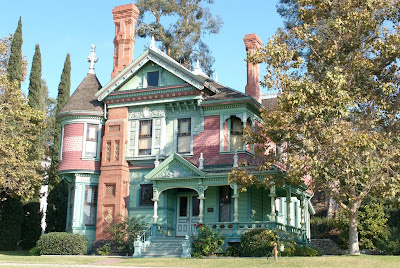
No comments:
Post a Comment